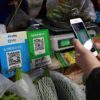The contest took place in the eastern city of Tianjin with the cars going across dirt racks, fields and roadways, having to avoid (and in many cases hit) various objects. The course was approximately the area of 10 football (soccer) fields. The conditions were designed to be challenging as the race organizers positioned fake cows and chickens in the way of the self-driving cars and at times created clouds of fog, designed to fully test out the imaging systems of the vehicles.
According to a report of the race in Bloomberg, while most of the cars successfully dodged the pretend farmyard animals, what proved more challenging was a craftily designed roadblock that narrowed the track. Attempting to traverse this, several cars succeeded in hitting the obstacle straight on. One car even drove straight into a market tent, despite only moving at 19 miles per hour (30 kilometers per hour). Each time contact was made, points were deducted from the racing vehicles final scores.
The racing cars included in the third edition of the race were those designed by Baidu Inc., Pony.ai., Beijing Electric Vehicle Co. and China FAW Group Co., plus prototypes from research labs and universities. The winning car was designed by Tsinghua University, Beijing.
While the race was designed for entertainment, it had a serious side as well in terms of testing out autonomous car technology. On the basis of what was seen, the technology still has someway to go before it can safely become a major feature on public roads. This is in the context of a high-profile incident involving Uber Technologies and Tesla, which caused the death of a pedestrian (in the first known case of a person killed by a self-driving vehicle).













